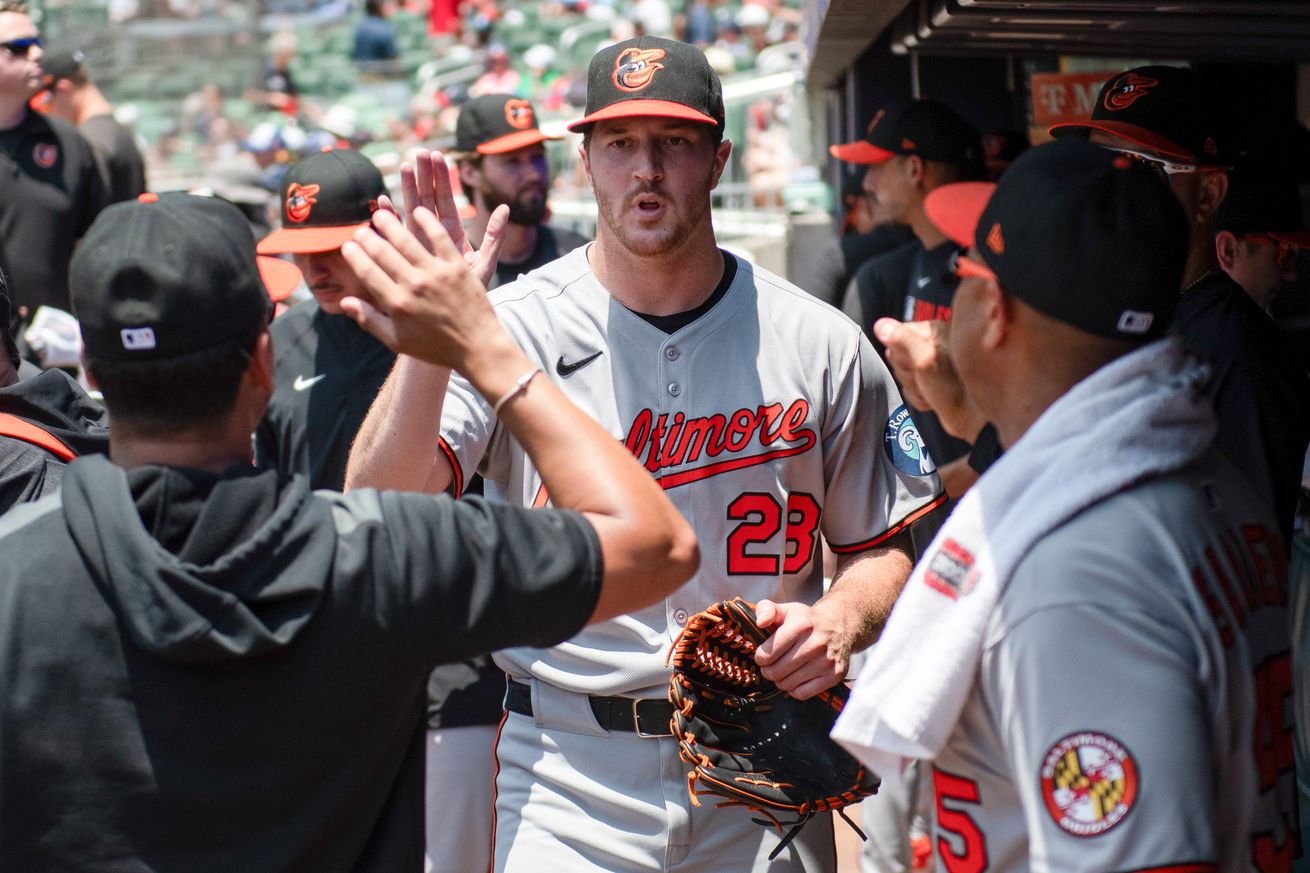
The entire staff has turned itself around since late May. That’s worth celebrating, and examining what went wrong earlier in the year.
This Orioles season can be nicely divided at one date: May 24th. Going into the second game of a doubleheader that day, the O’s were 16-34. Since then, they have gone 24-15. While just about every aspect of the team has been better since that date, the clearest difference has been on the pitching staff.
Through May 23, the Orioles were the worst pitching team in MLB, and it was not particularly close. They were the only unit with negative fWAR (-0.5), and ranked dead last in ERA (5.77) and FIP (5.11). Veterans like Charlie Morton (7.68 ERA), Zach Eflin (5.08 ERA), and Kyle Gibson (16.78) had been a disaster. The back of the bullpen had been a disappointment too with Yennier Cano (5.06 ERA, -0.1 fWAR), Seranthony Domínguez (6.06 ERA, -0.1 fWAR), and Félix Bautista (4.30 ERA, -0.1 fWAR) all struggling to varying degrees. The positives were few and far between.
Since May 24, the entire situation has flipped. The Orioles’ pitching staff has been the sixth-most valuable in MLB since then (5.0 fWAR). Their 3.97 ERA is middle of the pack while their 3.70 FIP ranks seventh in MLB. All of the numbers are a dramatic improvement.
At an individual level, there is plenty to like. Morton has completely turned his season around. The 41-year-old is 5-0 with a 2.97 ERA. Dean Kremer leads the staff with 1.1 fWAR. Bautista is striking out 14.82 per nine innings and has a 1.06 ERA. Domínguez (0.95 ERA), Bryan Baker (3.18 ERA), and Gregory Soto (3.14 ERA) have built a solid bridge to the back of the bullpen. And, of course, there is the reinvention of Trevor Rogers.
Rogers came to Baltimore at last year’s deadline. It was a “buy low” sort of move. The lefty was an all-star back in 2021, but the three seasons that followed were a struggle. That included a 4.53 ERA with Miami in 2024 prior to the trade. Mike Elias and the Orioles were betting that they could turn him back into his rookie-year form at some point in the 2.5 years of team control they were getting.
Until recently, that was not working out. Rogers had a 7.11 ERA over four starts for the Orioles in 2024. And his 2025 debut was delayed by a knee injury for several months. Meanwhile, the two players that that O’s had to give up (Connor Norby and Kyle Stowers) were thriving in Miami. Norby had a 107 OPS+ for the Marlins in ‘24. And Stowers has turned in an all-star season for them in ‘25. It seemed this trade would go firmly into Elias’ loss column.
But Rogers has now made five starts for the Orioles in 2025, and he has looked very good. Three of them have been shutout outings, including Sunday in Atlanta. Across 28.2 total innings the southpaw has a 1.57 ERA, 2.81 FIP, and 0.872 WHIP. He has pitched to contact, avoided walks, and kept hitters off balance with a five-pitch arsenal.
There is still a lot of baseball to play in 2025. That is time for Rogers to keep impressing or fall apart. But right now, the fact that he is under team control for 2026 feels like a brilliant bit of business by Elias. Between Rogers, Kremer, Kyle Bradish, and Grayson Rodriguez—if all healthy—the Orioles have a good starting point for next year’s rotation. Adding an “ace” should still be a priority, but the future state of the pitching staff is nowhere near as dire as it once felt.
This turnaround does lend some credence to Elias’ entire approach to the pitching staff this offseason. The group did have this sort of upside in its locker, and it hasn’t even included Rodriguez, whom the front office was likely expecting to be one of their top three starters.
The offseason reports on Rogers had been positive prior to his injury. If he had been this good all season—or close to it, anyway—maybe this entire year would feel different. The same goes for Morton, who was uncharacteristically awful in April. A full season of his career averages probably wins the O’s another game or two. Again, these were never the makings of an “elite” unit, but it would have been competitive and bought the team more time to right the ship, get Bradish back, etc.
That said, the recent improvement does not absolve Elias and his front office of blame for what did actually happen with the pitching this season. They made a choice to enter the year without an ace. They knew Bradish was out until late in the season, and they knew that Rodriguez had a history of arm issues. They should have done more to shore up the top of the rotation.
Of course, that is easier said than done, and it is always expensive. But is it more costly than potentially wasting a prime season of Gunnar Henderson, Adley Rutschman, Colton Cowser, Jordan Westburg, or Jackson Holliday? Because that could be what has happened here in 2025.
The hope will be that this season serves as a hard-learned lesson for Elias and others in the organization, should they remain. Yes, there was some logic in their process. It’s OK to take on a project like Rogers. But things were far from perfect. They needed to be more honest about the risks that came with the pitching staff they assembled. They needed to provide more wiggle room to the entire rotation, not just build depth at the very back of it. They needed to take bigger swings.
Pair some of that professional growth with better injury luck in 2026, and the Orioles could be the best candidates in MLB for a bounce-back next season.
